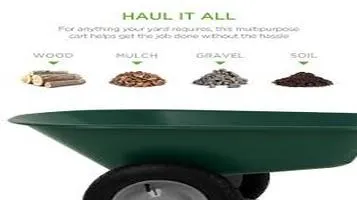Wheelbarrow An Indispensable Tool for Every Gardener and Builder
A wheelbarrow is a versatile and essential tool commonly used in gardening, construction, and landscaping. It typically consists of a shallow tray mounted on a single wheel at the front and two supporting legs at the back, with handles for maneuvering. The design allows for easy transport of heavy loads, as the wheel supports the weight while the user provides balance and direction. This makes it ideal for moving soil, gravel, plants, or building materials over short distances. The wheelbarrow's simplicity and efficiency make it indispensable for both professional and amateur tasks, reducing physical strain and saving time. Available in various materials like metal, plastic, or wood, wheelbarrows can be adapted for different terrains and loads, enhancing their utility across multiple applications.

Introduction
In the realm of gardening, construction, and various other forms of manual labor, few tools match the utility and versatility of a wheelbarrow. The humble wheelbarrow, with its simple yet effective design, has been a staple in both residential and commercial settings for centuries. This review delves into the various facets of this indispensable tool, highlighting its design, functionality, applications, and potential areas for improvement.
Design and Build Quality
Structure
At its core, the wheelbarrow is a straightforward piece of equipment. The primary components include a large open container or tray, one or more wheels, and two handles for maneuvering. The tray is typically made of steel, plastic, or wood, each material offering distinct advantages and disadvantages. Steel trays are durable and can handle heavy loads, but they are prone to rust. Plastic trays are lightweight and resistant to corrosion but may not withstand extremely heavy use. Wooden trays, though less common, offer a classic aesthetic and are relatively durable but require maintenance to prevent rot and wear.
Wheels
Most traditional wheelbarrows feature a single wheel situated at the front of the tray. This design allows for excellent maneuverability, especially in tight spaces. However, it also requires a fair amount of balancing skill, particularly when dealing with heavy or uneven loads. Modern iterations often incorporate two wheels, providing greater stability at the expense of some maneuverability. The choice between single and dual-wheel designs ultimately depends on the user's specific needs and preferences.
Handles
The handles are typically made of wood, metal, or plastic. Wooden handles are comfortable to grip and provide a bit of shock absorption, but they can splinter or crack over time. Metal handles are durable and can withstand substantial weight but may become uncomfortable during extended use. Plastic handles offer a compromise between comfort and durability, though they may not be as robust as their wooden or metal counterparts.
Functionality
Load Capacity
One of the primary metrics for evaluating a wheelbarrow is its load capacity. This refers to both the volume and weight it can carry. Standard wheelbarrows typically hold between 4 to 6 cubic feet of material and can support weights ranging from 300 to 500 pounds. Heavy-duty models can handle even larger volumes and weights, making them suitable for more demanding tasks.
Ergonomics
Ergonomics play a crucial role in the wheelbarrow's functionality. A well-designed wheelbarrow minimizes strain on the user's back and arms, even during prolonged use. Features such as padded handles, a balanced center of gravity, and easy-to-inflate pneumatic tires contribute significantly to user comfort. Some models also include additional features like foldable trays for easy storage or built-in tool holders for added convenience.
Applications
Gardening
For gardeners, the wheelbarrow is an invaluable tool. It simplifies the transport of soil, mulch, plants, and gardening tools, significantly reducing the physical effort required for these tasks. Whether you're moving heavy bags of compost or transporting delicate seedlings, a wheelbarrow can make the job much easier.
Construction
In the construction industry, wheelbarrows are indispensable for moving materials like concrete, bricks, gravel, and debris. Their ability to carry heavy loads over uneven terrain makes them a vital tool on any construction site. The robust construction and load-bearing capacity of heavy-duty wheelbarrows are particularly beneficial in this setting.
Landscaping
Landscapers also find wheelbarrows extremely useful for tasks such as moving stones, mulch, and other landscaping materials. The ability to navigate through various terrains, from smooth lawns to rocky paths, makes the wheelbarrow a versatile tool for any landscaping project.
Areas for Improvement
Material Durability
While modern wheelbarrows are generally well-constructed, there is always room for improvement in material durability. Enhancing the rust resistance of steel trays or increasing the load capacity of plastic trays could significantly extend the lifespan and utility of these tools.
Wheel Design
The choice between single and dual-wheel designs often comes down to a trade-off between stability and maneuverability. Future designs could explore hybrid models that offer the best of both worlds, perhaps through adjustable or interchangeable wheel configurations.
Ergonomic Enhancements
Additional ergonomic features could further improve user comfort and reduce strain. Innovations such as adjustable handle heights, cushioned grips, and shock-absorbing wheel systems could make the wheelbarrow even more user-friendly.
Conclusion
The wheelbarrow is a timeless tool that has proven its worth across various fields of manual labor. Its simple yet effective design, combined with its versatility and ease of use, make it an indispensable asset for gardeners, builders, and landscapers alike. While there is always room for improvement in terms of material durability, wheel design, and ergonomic features, the wheelbarrow remains a reliable and essential tool. Investing in a high-quality wheelbarrow is a decision that will undoubtedly pay off in the long run, providing years of valuable service and making numerous tasks significantly easier.






